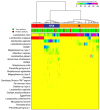The vaginal microbiota of pregnant women who subsequently have spontaneous preterm labor and delivery and those with a normal delivery at term
- PMID: 24987521
- PMCID: PMC4066267
- DOI: 10.1186/2049-2618-2-18
The vaginal microbiota of pregnant women who subsequently have spontaneous preterm labor and delivery and those with a normal delivery at term
Abstract
Background: This study was undertaken to determine whether the vaginal microbiota of pregnant women who subsequently had a spontaneous preterm delivery is different from that of women who had a term delivery.
Results: This was a nested case-control study of pregnant women who had a term delivery (controls) and those who had a spontaneous preterm delivery before 34 weeks of gestation (cases). Samples of vaginal fluid were collected longitudinally and stored at -70°C until assayed. A microbial survey using pyrosequencing of V1-V3 regions of 16S rRNA genes was performed. We tested the hypothesis of whether the relative abundance of individual microbial species (phylotypes) was different between women who had a term versus preterm delivery. A suite of bioinformatic and statistical tools, including linear mixed effects models and generalized estimating equations, was used. We show that: 1) the composition of the vaginal microbiota during normal pregnancy changed as a function of gestational age, with an increase in the relative abundance of four Lactobacillus spp., and decreased in anaerobe or strict-anaerobe microbial species as pregnancy progressed; 2) no bacterial taxa differed in relative abundance between women who had a spontaneous preterm delivery and those who delivered at term; and 3) no differences in the frequency of the vaginal community state types (CST I, III, IV-B) between women who delivered at term and those who delivered preterm were detected.
Conclusions: The bacterial taxa composition and abundance of vaginal microbial communities, characterized with 16S rRNA gene sequence-based techniques, were not different in pregnant women who subsequently delivered a preterm neonate versus those who delivered at term.
Keywords: Histologic chorioamnionitis; Infection-induced preterm delivery; Prematurity; Vaginal flora; Vaginal microbiome.
Figures


References
-
- World Health Organization. Born Too Soon: The Global Action Report in Preterm Birth. Geneva; 2012.
-
- Premature Birth. [ http://www.marchofdimes.com/peristats/Peristats.aspx]
-
- Hamilton BE, Martin JA, Ventura SJ. Births: preliminary data for 2012. Natl Vital Stat Rep. 2012;62:1–20. - PubMed
-
- Goldenberg RL, McClure EM. In: Preterm Birth: Prevention and Management. Berguella V, editor. Oxford: Willey-Blackwell; 2010. The epidemiology of preterm birth; pp. 22–38.
LinkOut - more resources
Full Text Sources
Other Literature Sources
Medical
Miscellaneous

